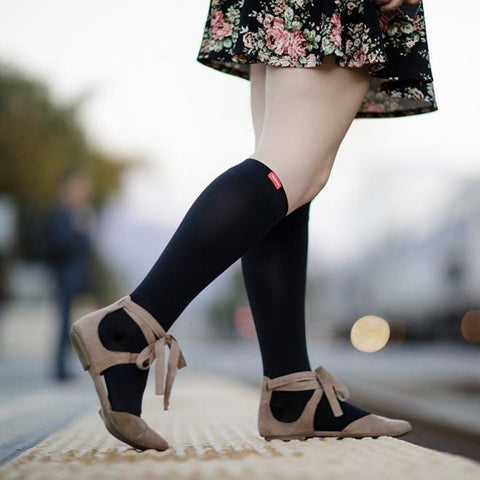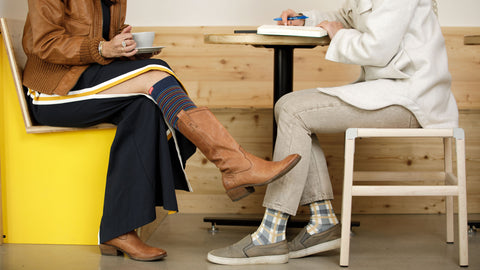What are the Benefits of Compression Socks for Vasculitis?
Vasculitis can be an uncomfortable, debilitating condition. On the legs, this blood vessel inflammation leads to blood pooling and not flowing freely, causing pain, discomfort, swelling, and irritation. Compression socks may relieve some of these symptoms.
Thanks to the way they stimulate blood flow in the limbs and massage the muscles, compression socks can be an effective tool for relieving the symptoms of vasculitis of the legs.
Read on to find out more about vasculitis and how you can use compression socks to manage its symptoms.

Do Compression Socks Help With Vasculitis?
Vasculitis is a rare condition that affects the blood vessels. It can become very serious and needs to be treated by a medical professional. The key to effective treatment is understanding and addressing its causes. While compression socks do not treat vasculitis specifically, they offer welcome relief from swelling and pain and are an effective tool for managing the disease’s symptoms.
Graduated compression socks boost blood flow in the lower legs, which is a key problem for vasculitis patients. Better blood circulation can reduce inflammation and relieve pain and discomfort. It also contributes to reducing the swelling caused by blood pooling in the legs. Finally, compression socks can help prevent future complications around peripheral circulation, such as blood clots and venous insufficiency.
What is Vasculitis?
Vasculitis is an inflammation of the blood vessels, which can happen around one or several organs. It can cause the walls of the blood vessels to get thicker, which makes it harder for blood to go through. As a result, you can suffer from restricted blood flow that leads to other types of damage.
Although vasculitis is a relatively rare disease, it can affect anyone and can be long-lasting or shorter term. Some types of vasculitis are more common with specific age groups. Some forms are also associated with working out - for example, exercise-induced vasculitis that sets in after vigorous activity, usually in hot weather. Others include allergic reactions to drugs or food, such as in the case of leukocytoclastic vasculitis.
For some patients, symptoms may improve without treatment. Others may need specific medical attention or medication to bring down the inflammation.
It is possible for vasculitis of the legs to occur: this is when the blood vessels become inflamed in the lower limbs (often the case with exercise-induced vasculitis). A first symptom of it is red or purple dots on the skin (called petechiae). Larger spots (called purpura) can look like bruises, but they don’t fade away after a few days. Leg hives are also a possible side effect.
As a result of vasculitis of the legs, you may feel pains and aches and notice the legs and ankles swelling as blood pools in the veins without the same ability to flow freely.

The Benefits of Compression Socks for Vasculitis
Thanks to boosting blood flow in the lower limbs, compression stockings and socks play a part in relieving some of the symptoms associated with leg vasculitis.
Improving Circulation
Compression socks work by applying graduated pressure to the lower limbs. A tighter grip on the lowest part of the leg, slowly becoming looser towards the knee, stimulates circulation of the blood upwards. This ensures good peripheral blood flow and keeps swelling and inflammation down.
In cases of leg vasculitis, the help with blood flow can at least manage some of the pain and swelling associated with the condition. It can reduce inflammation and reduce redness and irritation on the skin surface.
Reducing Swelling and Edema
Most of the swelling linked to leg vasculitis is caused by a build-up of blood in the lower leg blood vessels. By pushing blood throughout the body and especially upwards towards the heart, wearing compression socks can offer relief from this symptom. This is why compression socks are often prescribed to patients suffering from edema.
Pain Management
Compression socks act on pain in two ways: firstly, through boosted blood flow that should bring down inflammation and pressure in the blood vessels, which causes the leg pain; and secondly, through a gentle massage of the muscles.
While massaging the lower legs provides momentary pain relief, it can also contribute to lowering swelling and keeping legs feeling fresher and more energized.
Preventing Future Complications
Any obstruction to normal blood circulation runs the risk of further complications. These can include deep vein thrombosis, varicose veins, blood clots, and more. Thanks to the continued support that compression socks provide to blood flow in the lower limbs, these risks are reduced.
Using Compression Socks for Vasculitis Effectively
Compression socks are one of the tools that patients can use when suffering from vasculitis of the legs. They’re particularly effective in reducing inflammation and swelling. To make the most of them, you’ll need to wear them consistently and consult with your doctor if you have any doubts or if there are any side effects.
The Importance of Consistency
The treatment of vasculitis depends on individual diagnosis and the severity of the condition. It can often involve medication and other specialist interventions. However, to reduce long-term swelling and inflammation and to prevent complications, wearing compression socks consistently can make a difference. This means you will need to start with short periods of time wearing them, then gradually increase to what is comfortable for you. But the key is to not just simply wear them once and expect “magic” results. Wearing your socks regularly, e.g. every day for 4 hours, will make more of an impact than one single use. Moreover, it takes time for compression therapy to affect blood flow or reduce swelling - find out more here.
When and How Long to Wear Them
For first-time wearers, compression socks may feel somewhat uncomfortable, or at least unfamiliar. This is why we recommend starting with a few hours of wear at a time, before you become used to the sensations. Then, you can gradually build on this and wear your socks for the whole day if you wish to do so.
Wear compression socks before a big day out to preempt swelling related to the heat and effort and to start off with warmed up muscles. Equally, you can wear them at the end of the day for relaxing and soothing muscles and joints. Experiment with different scenarios to see what works best for you.

Choosing the Best Compression Socks for Vasculitis
To get the benefits of compression socks for vasculitis of the legs, it’s essential to have a pair that fits well, applies the right amount of pressure, and is in the style that you need for your activity or personal preference. Here are some things to think about when making your decision.
Types of Compression Socks to Consider
Compression socks are not all identical. The most popular and best-known style is the below-the-knee sock that squeezes the lower legs from the feet up and covers the calf muscles and the shins. These are great for everyday wear and for sports activities.
Additionally, you can benefit from calf sleeves if you only want to focus on boosting blood flow to the calf muscles and wish to go barefoot (e.g. in sandals in the summer). This is also a good option for vasculitis patients who can identify areas where the condition is visible, e.g. on the shins or back of the legs.
For those looking for some support around the ankle, but who need to have more ventilation to the toes, open-toe compression socks are the best option. Finally, for more coverage that goes up the legs and boosts blood flow above the knee, you can opt for compression tights or leggings.
Sizing and Fit
For compression to work, adequate pressure needs to be applied to the legs. Otherwise, your socks will simply roll down and not have any impact on blood flow. Of course, if your compression socks are too tight, this can be painful, uncomfortable, and lead to more issues.
To ensure best fit, follow our sizing guidelines and begin by measuring your calf circumference. Remember that compression socks need to fit tightly, but not uncomfortably so, and you should feel a massage to the muscles when you have them on.
Compression Level
There are several levels of pressure applied by compression socks, measured in mmHg. For regular wear, sports activities, and recovery after exercise, the best option is to go for moderate compression (15-20 mmHg), which you can buy without a prescription.
People suffering from circulatory problems, in conjunction with their doctor, may wish to go for higher levels of compression at 20-30 mmHg or 30-40 mmHg.
The Importance of Graduated Compression
For an effective boost in peripheral circulation, vasculitis patients should prioritize graduated compression socks. They are tighter towards the feet and less so towards the knee, which stimulates the upwards travel of blood through the body. As a result, there is less of a risk of swelling and blood pooling at the periphery - so less inflammation and discomfort.

Complementary Management Strategies
As we’ve mentioned above, compression socks are just one of the tools you can use to combat the symptoms of leg vasculitis. Here are some other ways to manage this condition.
Proper Diet and Hydration
Eating well is essential for overall wellbeing. In the case of vasculitis, it can also help counter any side effects that can come from medication (such as thinning bones, high blood pressure, or diabetes). Focus on adding in fresh fruit and vegetables and lean meats and fish to your daily meals.
It’s also important to consume low-fat dairy. If you are on corticosteroids, ask your doctor if supplementing with calcium or vitamin D will work for you.
Low Impact Exercise
Many vasculitis patients that use medication are prescribed corticosteroids. Their side effects include bone loss, high blood pressure, and diabetes. All of these can be prevented through regular low impact exercise. Moreover, exercising helps improve your mood and your overall wellbeing - so adding it into your life gradually may pay dividends.
Heat and Cold Therapy
Some people enjoy either heat or cold therapy for finding relief from pain and irritation associated with vasculitis. Certainly, icing your rashes on a hot day can feel good. However, it’s important to know that circulatory issues sometimes come in conflict with these therapies. So, consult with your doctor before starting them.
Stress Management
Some vasculitis cases are linked to high stress levels. It is important, in these scenarios, to work on balancing your workload and everyday stress levels, focusing on wellbeing and calm. Enjoy fresh air, including a 20-30 minute walk in your daily routine. Ensure you go to bed at a consistent time every night and rest well. If this works for you, add meditation to your day to ground you and allow you to slow down. All these actions can reduce stress and enable you to manage vasculitis flares.
Medical Interventions
Your doctor will come up with a treatment plan for your vasculitis if you need more serious medical attention. This can include a series of tests and checking your blood pressure regularly. For some people, it also includes taking corticosteroids, which control the inflammation in your body. Find out more by discussing with your doctor.



















Leave a comment